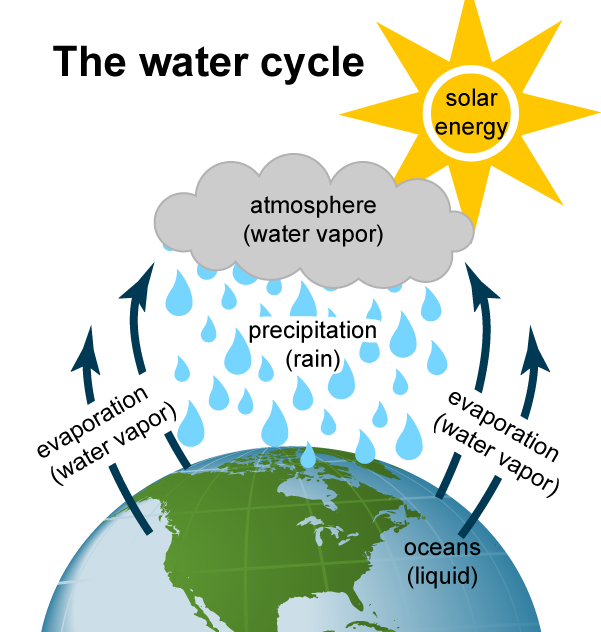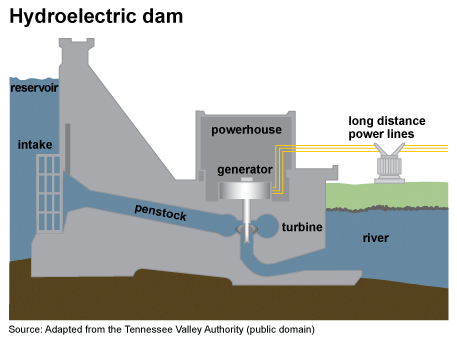Hydropower is energy in moving water
People have a long history of using the force of water flowing in streams and rivers to produce mechanical energy. Hydropower was one of the first sources of energy used for electricity generation, and until 2019, hydropower was the leading source of total annual U.S. renewable electricity generation.
In 2022, hydroelectricity accounted for about 6.2% of total U.S. utility-scale1 electricity generation and 28.7% of total utility-scale renewable electricity generation. Hydroelectricity generation varies annually, and it's share of total U.S. electricity generation generally decreased from the 1950's through 2020, mainly because of increases in electricity generation from other sources. Hydroelectricity's percentage share of total annual U.S. electricity generation in 2001 through 2022 averaged about 6.7%.
Hydropower relies on the water cycle
Understanding the water cycle is important to understanding hydropower. The water cycle has three steps:
- Solar energy heats water on the surface of rivers, lakes, and oceans, which causes the water to evaporate.
- Water vapor condenses into clouds and falls as precipitation—rain and snow.
- Precipitation collects in streams and rivers, which empty into oceans and lakes, where it evaporates and begins the cycle again.
The amount of precipitation that drains into rivers and streams in a geographic area determines the amount of water available for producing hydropower. Seasonal variations in precipitation and long-term changes in precipitation patterns, such as droughts, can have significant effects on the availability of hydropower production.
Hydroelectric power is produced with moving water
Because the source of hydroelectric power is water, hydroelectric power plants are usually located on or near a water source. The volume of the water flow and the change in elevation—or fall, and often referred to as head—from one point to another determine the amount of available energy in moving water. In general, the greater the water flow and the higher the head, the more electricity a hydropower plant can produce.
At hydropower plants water flows through a pipe, or penstock, then pushes against and turns blades in a turbine that spin to power a generator to produce electricity.
Conventional hydroelectric facilities include:
- Run-of-the-river systems, where the force of the river's current applies pressure on a turbine. The facilities may have a weir in the water course to divert water flow to hydro turbines.
- Storage systems, where water accumulates in reservoirs created by dams on streams and rivers and is released through hydro turbines as needed to generate electricity. Most U.S. hydropower facilities have dams and storage reservoirs.
Pumped-storage hydropower facilities are a type of hydroelectric storage system where water is pumped from a water source up to a storage reservoir at a higher elevation. The water is released from the upper reservoir to power hydro turbines located below the upper reservoir. They usually pump water to storage when electricity demand and generation costs, or when wholesale electricity prices are relatively low, and release the stored water to generate electricity during peak electricity demand periods when wholesale electricity prices are relatively high. Pumped-storage hydroelectric systems generally use more electricity to pump water to the upper water storage reservoirs than they produce with the stored water. Therefore, pumped-storage facilities have net negative electricity generation balances.
Hydropower has a long history
Hydropower is one of the oldest sources of energy for producing mechanical and electrical energy, and up until 2019, it was the largest source of total annual U.S. renewable electricity generation. Thousands of years ago, people used hydropower to turn paddle wheels on rivers to grind grain. Before steam power and electricity were available in the United States, grain and lumber mills were powered directly with hydropower. The first industrial use of hydropower to generate electricity in the United States was in 1880 to power 16 brush-arc lamps at the Wolverine Chair Factory in Grand Rapids, Michigan. The first U.S. hydroelectric power plant to sell electricity opened on the Fox River near Appleton, Wisconsin, on September 30, 1882.
There are about 1,450 conventional and 40 pumped-storage hydropower plants operating in the United States. The oldest operating U.S. hydropower facility is the Whiting plant in Whiting, Wisconsin, which started operating in 1891 and has a total generation capacity of about 4 megawatts (MW). Most U.S. hydroelectricity is produced at large dams on major rivers, and most of these hydroelectric dams were built before the mid-1970s by federal government agencies. The largest U.S. hydropower facility, and the largest U.S. electric power plant in electric generation capacity, is the Grand Coulee hydro dam on the Columbia River in Washington State, with 6,765 MW total generation capacity.
1 Utility-scale power plants have at least 1 MW (or 1,000 kilowatts) of total net electric generation capacity.
Last updated: April 20, 2023, with most recent data available.


